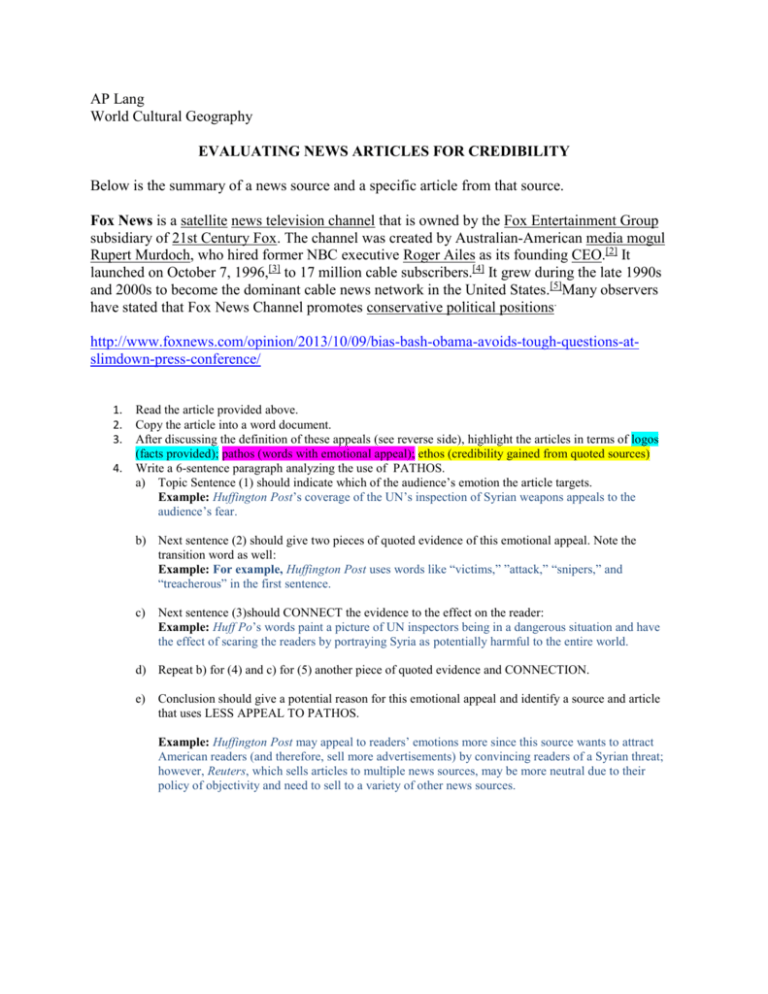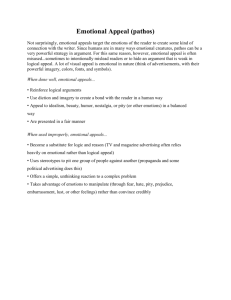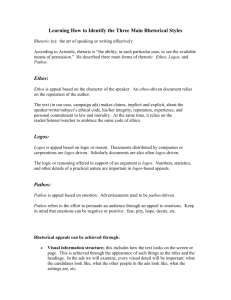BiasExerciseGovShutd..
advertisement

AP Lang World Cultural Geography EVALUATING NEWS ARTICLES FOR CREDIBILITY Below is the summary of a news source and a specific article from that source. Fox News is a satellite news television channel that is owned by the Fox Entertainment Group subsidiary of 21st Century Fox. The channel was created by Australian-American media mogul Rupert Murdoch, who hired former NBC executive Roger Ailes as its founding CEO.[2] It launched on October 7, 1996,[3] to 17 million cable subscribers.[4] It grew during the late 1990s and 2000s to become the dominant cable news network in the United States.[5]Many observers have stated that Fox News Channel promotes conservative political positions. http://www.foxnews.com/opinion/2013/10/09/bias-bash-obama-avoids-tough-questions-atslimdown-press-conference/ 1. 2. 3. 4. Read the article provided above. Copy the article into a word document. After discussing the definition of these appeals (see reverse side), highlight the articles in terms of logos (facts provided); pathos (words with emotional appeal); ethos (credibility gained from quoted sources) Write a 6-sentence paragraph analyzing the use of PATHOS. a) Topic Sentence (1) should indicate which of the audience’s emotion the article targets. Example: Huffington Post’s coverage of the UN’s inspection of Syrian weapons appeals to the audience’s fear. b) Next sentence (2) should give two pieces of quoted evidence of this emotional appeal. Note the transition word as well: Example: For example, Huffington Post uses words like “victims,” ”attack,” “snipers,” and “treacherous” in the first sentence. c) Next sentence (3)should CONNECT the evidence to the effect on the reader: Example: Huff Po’s words paint a picture of UN inspectors being in a dangerous situation and have the effect of scaring the readers by portraying Syria as potentially harmful to the entire world. d) Repeat b) for (4) and c) for (5) another piece of quoted evidence and CONNECTION. e) Conclusion should give a potential reason for this emotional appeal and identify a source and article that uses LESS APPEAL TO PATHOS. Example: Huffington Post may appeal to readers’ emotions more since this source wants to attract American readers (and therefore, sell more advertisements) by convincing readers of a Syrian threat; however, Reuters, which sells articles to multiple news sources, may be more neutral due to their policy of objectivity and need to sell to a variety of other news sources. Logos (Message) Argument or Media Ethos (Author) (Audience) Pathos Logos: Rational or Logical Appeals. Appeal to logical reasoning ability of the audience through use of facts, case studies, statistics, experiments, logical reasoning, analogies, anecdotes, authority voices, etc. Are writer’s claims reasonable? Is there sufficient evidence to support those claims? Does the speaker make logical conclusions? Does he/she talk about counterarguments, other opinions or points of view? Pathos: Emotional Appeals. Appeal to beliefs/feelings of the audience. An appeal of pathos can move an audience to anger or tears as a means of persuasion. It may attempt to invoke particular emotions such as fear, envy, patriotism, lust, etc. Or, an appeal of pathos may stem from shared values between the author and the audience, or from an argument that caters to an audience’s beliefs. Ethos: Ethical Appeals. Appeal based on the character, persona, and/or position of the speaker. This kind of appeal gives the audience a sense of the author as a competent/fair authority figure. Such an appeal may highlight the author’s trustworthiness, credibility, reliability, expert testimony, reliable sources, fairness, celebrity, etc.






